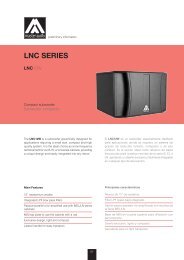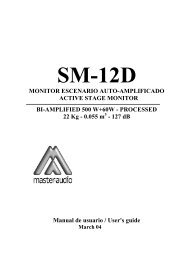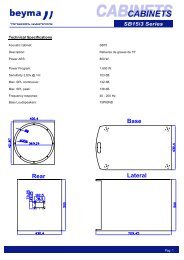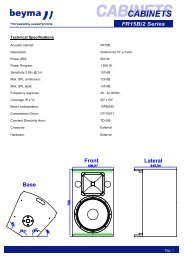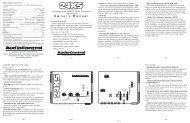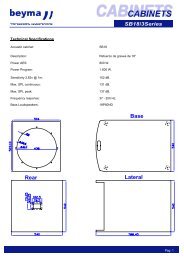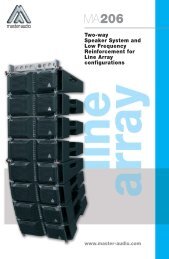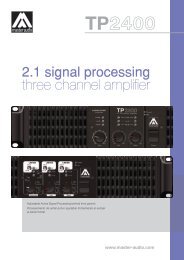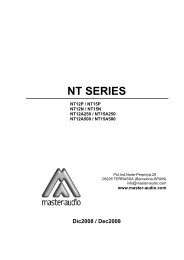tpl-150 Beyma esen
tpl-150 Beyma esen
tpl-150 Beyma esen
Create successful ePaper yourself
Turn your PDF publications into a flip-book with our unique Google optimized e-Paper software.
TPL-<strong>150</strong> Pleated Diaphragm Tweeter<br />
<strong>Beyma</strong> introduces a new type of component for the professional sound, bringing<br />
the highest sonorous quality of the most demanding audiophile to the world of<br />
live music.<br />
This type of high frequency transducer is based on the AMT technology (Air<br />
Motion Transformer). In this type of transducers, invented by the German<br />
physicist Oskar Heil, the generation of the sound takes place in a very different<br />
way than habitual in ribbon tweeters. In figure one, we can see that in this<br />
device, the diaphragm is formed by longitudinal folds, like in an accordion. In<br />
the straight face of each one of these folds, there is a printed conductive copper<br />
thread.<br />
The advantage in this type of device consist in the small and very controlled<br />
movement of each fold, accelerating the surrounding air inside each fold, which<br />
produces an almost perfect acoustical output, both in amplitude and in phase in<br />
all the radiating area of the transducer.
This diaphragm is made in <strong>Beyma</strong>, on a material able to support extreme<br />
temperatures and of a great flexibility. It is used in military and aerospace<br />
applications to manufacture flexible printed circuits. It is of great durability and<br />
reliability.<br />
The operation principle is the same one that in a regular tweeter, but geometry<br />
is totally different:<br />
NORTH<br />
SOUTH<br />
MAGNETIC<br />
FIELD<br />
DIRECTION<br />
FOLDS MOTION<br />
NORTH<br />
SOUTH<br />
As it is possible to be seen in this figure, the magnetic field is closed happening<br />
by where the diaphragm is located. When an alternating electrical current<br />
circulates along the copper threads of the membrane, a movement takes place<br />
in the folds from left to right. The sound wave is generated when the air<br />
between the folds is compressed.<br />
This causes that, being the displacement of each fold very small, the air moves<br />
at great speed, producing an important sound pressure.
The advantages of this type of tweeter can be summarized in:<br />
- Radiating surface four times the one of a tweeter or an equivalent<br />
compression driver, thanks to its folded geometry.<br />
- Mobility transformer of air (Air Motion Transformer) because it causes<br />
in the air a speed four times greater than the one of the folds<br />
themselves (relation 4:1).<br />
- This confers an enormous dynamics and an incredible transient<br />
response, vastly superior to that of any conventional tweeter,<br />
including ribbon tweeters and compression drivers.<br />
What <strong>Beyma</strong> has done has been to develop this technology creating a<br />
component for professional use, of which would be possible to emphasize:<br />
- High sensitivity: 99 dB@1W, 1m.<br />
- Wide frequency range: from 1 to 23 kHz.<br />
- Admissible power handling without precedents: 80 W AES.<br />
- Directly applicable for Line Array systems, with total coherence of<br />
the wave front with no need of any adapter.<br />
- Also suited for other conventional applications, with a horizontal<br />
coverage superior to 100º up to 10 kHz.<br />
All these characteristics make of the TPL-<strong>150</strong> an authentic alternative to the<br />
conventional compression drivers, and contributing an enormous added value<br />
to any sound system that incorporates it. The sonic quality, timbre, definition<br />
and clarity of this transducer are simply unsurpassable.<br />
Frequency Response 1W@1m without baffle neither horn
By looking to the frequency response, although usable from 1 kHz, it may<br />
seems that the sound pressure level until 2 kHz is lower than requested for an<br />
equivalent use as a compression driver. It should be taken into account that this<br />
response is achieved without any horn or baffle, just with the unit in free air. In<br />
these conditions, the horizontal dispersion of the TPL-<strong>150</strong> is completely<br />
awesome.<br />
Note: heavy line, horizontal beamwidth; discontinous line vertical beamwidth.<br />
As it can be seen in the dispersion chart, the horizontal coverage is 180º at less<br />
than 1 kHz. By using a small diffuser, limiting the coverage at those frequencies<br />
to 90º is very effective to achieve a higher SPL from 800 Hz to 5 kHz, getting<br />
more than 4 dB increment, without loosing the spectacular dispersion<br />
consistence. No compression driver with horn is able to have 100º coverage<br />
angle at 10 kHz. Next we can find a frequency response with a new horn, the<br />
TDTPL, to reinforce the low-mid band-pass of the TPL-<strong>150</strong>:<br />
Horn used for the measurement
TPL-<strong>150</strong> with/without 80ºx30º horn<br />
With the help of this horn, the TPL-<strong>150</strong> gets a much higher sensitivity,<br />
especially from 1 to 7 kHz, with an average sensitivity about 104 dB, and still<br />
maintains a very low distortion figure.<br />
But how does the TPL-<strong>150</strong> compare to a normal compression driver? In <strong>Beyma</strong>,<br />
we have made an extended and complete set of measurements to illustrate the<br />
superiority of the TPL over a conventional compression driver. In the next table<br />
we can compare the specifications of the TPL compared to the used<br />
compression driver in the comparison:<br />
SPECS COMPRESSION DRIVER TPL-<strong>150</strong><br />
Power Handling 70W AES (3 in. voice coil) 80W AES<br />
Av. Sensitivity with Horn 108 dB 104 dB<br />
Horn Coverage 80ºx50º 80ºx30º<br />
Voice Coil Material Copper Copper<br />
X-Over frequency 0.8 kHz 1 kHz<br />
Diaphragm Material Ti Dome with mylar surround Kapton<br />
Let’s start with time definition. A waterfall plot will be very self-explanatory about<br />
the difference between a dome with unavoidable resonances and time smearing<br />
and a structure where the voice coil itself is the radiating surface at the same<br />
time:
TPL-<strong>150</strong> Waterfall, less than 2 msec. time response<br />
Comp. driver Waterfall, more than 5 msec. time response<br />
As we can see in the Waterfall measurements, almost all the energy in the TPL-<br />
<strong>150</strong> has gone away in less than 2 milliseconds. However, if we look the<br />
compression driver response, even after 5 milliseconds, the diaphragm is still<br />
resonating, blurring the acoustic message.<br />
What about distortion products?<br />
Many different measurements were carried out, including but no limited to<br />
harmonic distortion, difference tone distortion, inter-modulation distortion, near<br />
field measurements and multi-tone stimulus, all of them at three different power<br />
levels, 1W, 7W and 23W AES. We can show many of all these measurements,<br />
where always the TPL-<strong>150</strong> is clearly superior in terms of distortion.<br />
We will start with a simple harmonic distortion, measured until the 5 th harmonic,<br />
as recent investigations in subjective impact of distortions suggest that higher<br />
order harmonics can be more detrimental in the appreciated quality, as they are<br />
not masked by the main response of the reproducing device.
1W Harmonic Dsitortion measurement COMP. DRIVER<br />
1W Harmonic Distortion measurement TPL-<strong>150</strong><br />
Already in this first and common measurement, a clear advantage of the TPL-<br />
<strong>150</strong> can be observed, in terms of the relative amplitude of harmonic distortion<br />
products.<br />
Many other distortion measurements could be included, but we will show the<br />
inter-modulation distortion, just as add-on of a more standard measurement,<br />
although not as widely used as harmonic distortion.
1W Inter-modulation Distortion COMP. DRIVER<br />
1W Inter-modulation Distortion TPL-<strong>150</strong><br />
This inter-modulation Distortion is just like looking to one specific type of<br />
distortion of a multi-tone measurement, but still very interesting how low is the<br />
inter-modulation in the TPL-<strong>150</strong> compared to the compression driver.<br />
But one of the most spectacular measurements is the multi-tone response, as it<br />
can be more related with the behaviour of the unit with musical signals. Using<br />
various sinusoidal signals at the same time, many more inter-related distortion<br />
products arise, creating a kind of a “noise floor”, extremely interesting to<br />
compare, specially in this case.
In the graph, we can clearly see the tremendous quantity of distortion products<br />
the compression driver is creating, just with one watt. There is a S/N ratio of<br />
less than 45 dB between the main component and the distortion products, along<br />
all the band pass of the unit. If we look to the blue trace of the TPL-<strong>150</strong>, it is<br />
incredible how low the distortion is, not even possible to measure it in many<br />
frequency regions.<br />
dB<br />
100<br />
90<br />
80<br />
70<br />
60<br />
50<br />
40<br />
30<br />
20<br />
dB<br />
110<br />
100<br />
90<br />
80<br />
70<br />
60<br />
50<br />
40<br />
30<br />
200<br />
900<br />
200<br />
900<br />
1600<br />
2300<br />
1600<br />
2300<br />
3000<br />
3700<br />
3000<br />
3700<br />
4400<br />
5100<br />
4400<br />
5100<br />
5800<br />
6500<br />
5800<br />
6500<br />
1W Multitone Response<br />
7200<br />
7900<br />
8600<br />
9300<br />
10000<br />
10700<br />
11400<br />
12100<br />
1W Multitone measurement<br />
7W Multitone Response<br />
7200<br />
7900<br />
8600<br />
9300<br />
10000<br />
10700<br />
11400<br />
12100<br />
7W Multitone measurement<br />
12800<br />
13500<br />
12800<br />
13500<br />
14200<br />
14900<br />
14200<br />
14900<br />
COMP. DRIVER TPL-<strong>150</strong><br />
15600<br />
16300<br />
15600<br />
16300<br />
17000<br />
17700<br />
17000<br />
17700<br />
18400<br />
19100<br />
18400<br />
19100<br />
19800<br />
COMP. DRIVER TPL-<strong>150</strong><br />
19800<br />
Hz<br />
Hz
We can also look to the 7W measurement, where it can also be appreciated<br />
how the distortion products raises dramatically with power applied in the<br />
compression driver, while in the TPL-<strong>150</strong>, the distortion noise floor is kept<br />
proportional to the power applied.<br />
So, not only the distortion is very low in the TPL-<strong>150</strong>, but also it does not arise<br />
dramatically with power applied, as a compression driver does.<br />
As a conclusion, this new transducer will be a key component for the next level<br />
of professional sound systems of the future, in terms of sonic quality and Live<br />
Sound experience.<br />
For more information, please visit http://profesional.beyma.com or contact<br />
beyma@beyma.com<br />
REFERENCES<br />
[1] S. Temme, “Why and How to Measure Distortion in Electroacoustic<br />
Transducers,” pr<strong>esen</strong>ted at the AES 11th Conference on Audio Test and<br />
Measurement (Portland, OR, 1992 May 29–31).<br />
[1] E. Czerwinsky, A. Voishvillo, S. Alexandrov, and A. Terekhov, “Multitone<br />
Testing of Sound System Components—Some Results and Conclusions, Part<br />
1: History and Theory,” J. Audio Eng. Soc., vol. 49, pp. 1011–1048 (2001 Nov.).<br />
[3] E. Czerwinsky, A. Voishvillo, S. Alexandrov, and A. Terekhov, “Multitone<br />
Testing of Sound System Components—Some Results and Conclusions, Part<br />
2: Modeling and Application,” J. Audio Eng. Soc., vol. 49, pp. 1181–1192 (2001<br />
Dec.).<br />
[4] Czerwinski, Gene; Alexandrov, Sergei; Voishvillo, Alexander; Terekhov,<br />
Alexander “Graphing, Interpretation, and Comparison of the Results of<br />
Loudspeaker Nonlinearity Measurement” (113 th Convention, October, 2002)<br />
[5] Alex Voishvillo, “Assessment of Nonlinearity in Transducers and Sound<br />
Systems – from THD to Perceptual Models”, (121st AES Convention, San<br />
Francisco, October 6, 2006, preprint 6910)
TPL-<strong>150</strong><br />
ALUMINUM FRONT<br />
PLATE<br />
NEODYMIUM<br />
MAGNETS<br />
PLEATED<br />
DIAPHRAGM<br />
ABS DIAPHRAGM<br />
FRAME<br />
POLE PIECES<br />
BACK COVER



